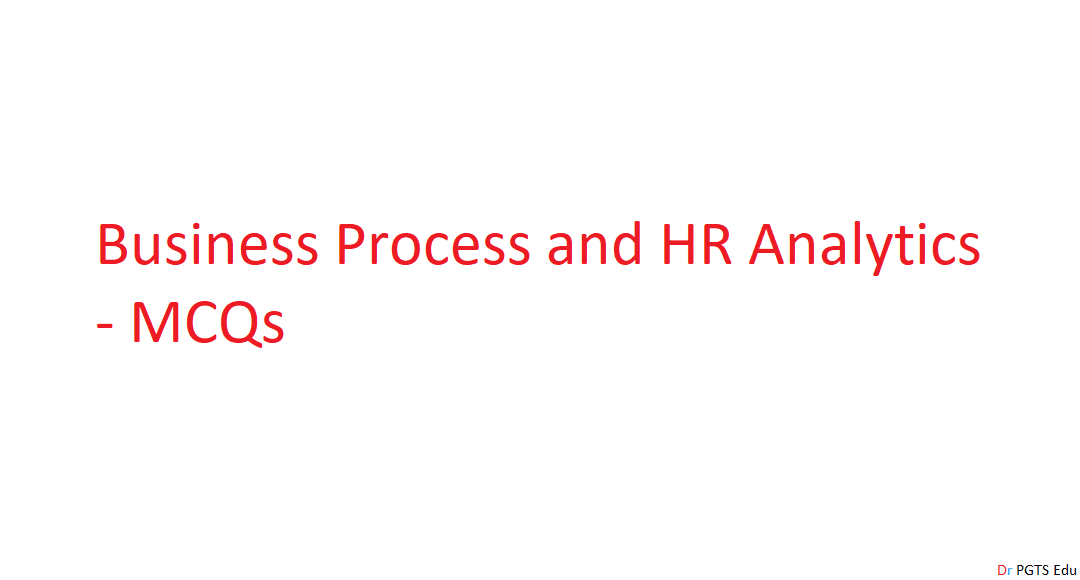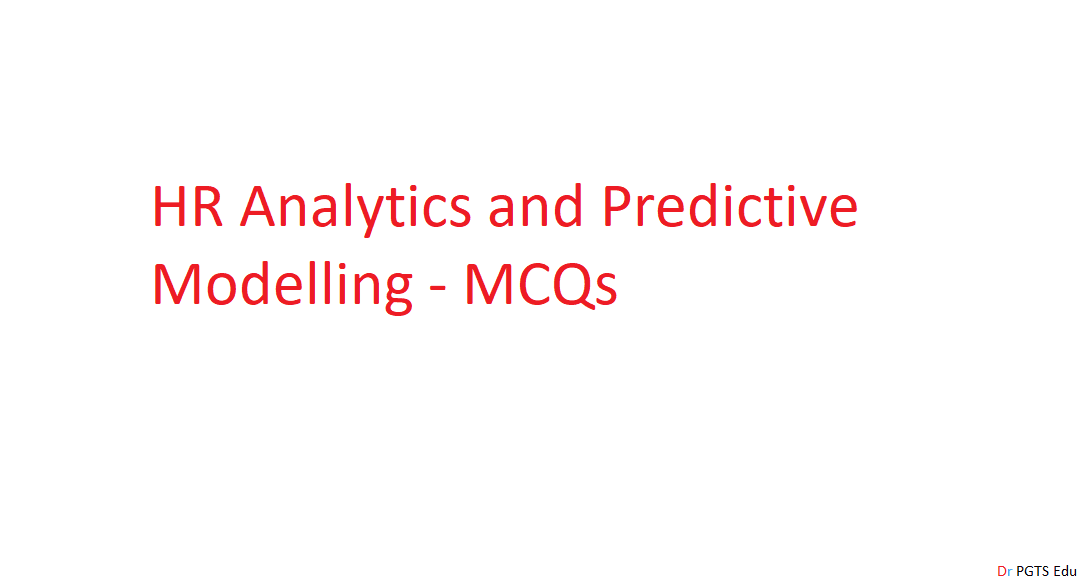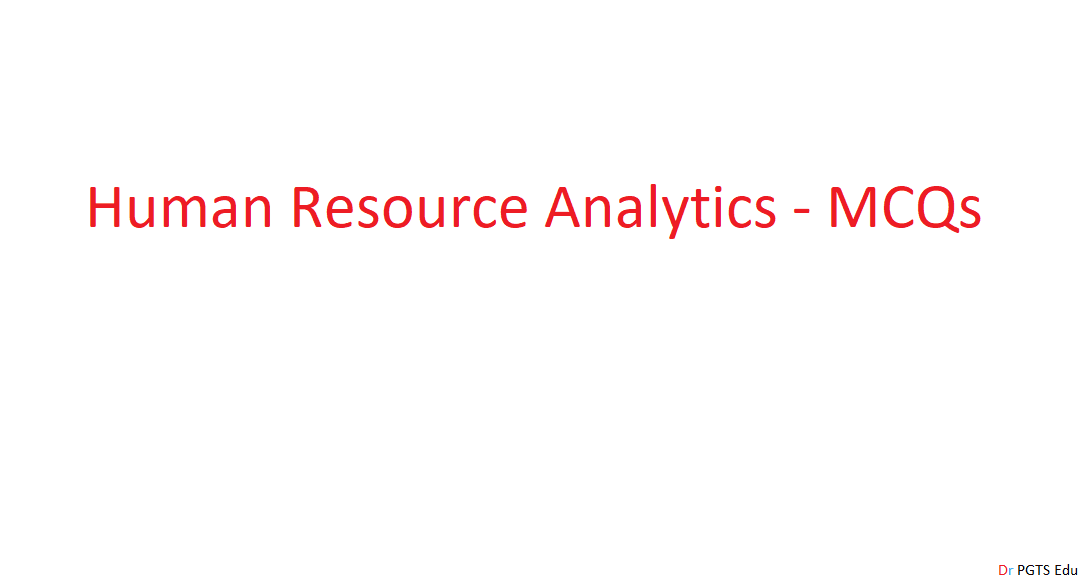Human Resource Analytics – MCQs
1. What is the primary goal of Human Resource Analytics?
A) To track employee attendance
B) To analyze HR data and improve decision-making
C) To manage payroll systems
D) To hire new employees
Answer: B) To analyze HR data and improve decision-making
2. Which of the following is NOT a benefit of HR analytics?
A) Enhanced employee performance
B) Reduced recruitment costs
C) Increased manual data entry
D) Improved retention rates
Answer: C) Increased manual data entry
3. What type of data is primarily used in HR analytics?
A) Financial data
B) Employee-related data
C) Weather data
D) Customer data
Answer: B) Employee-related data
4. Which tool is commonly used in HR analytics for data visualization?
A) Microsoft Word
B) PowerPoint
C) Tableau
D) Notepad
Answer: C) Tableau
5. Predictive analytics in HR is used for:
A) Forecasting future employee performance
B) Managing office supplies
C) Organizing team outings
D) Creating job descriptions
Answer: A) Forecasting future employee performance
6. What does HR analytics use to measure employee engagement?
A) Email frequency
B) Employee surveys and feedback
C) Social media posts
D) Office decoration
Answer: B) Employee surveys and feedback
7. Which HR metric is commonly analyzed in workforce analytics?
A) Employee turnover rate
B) Monthly electricity bill
C) Number of office chairs
D) Weather conditions
Answer: A) Employee turnover rate
8. Descriptive analytics in HR is used to:
A) Explain past trends and patterns
B) Predict future employee behavior
C) Suggest the best hiring candidates
D) Replace HR professionals
Answer: A) Explain past trends and patterns
9. HR analytics is most useful for:
A) Making data-driven HR decisions
B) Replacing employees with robots
C) Writing employee handbooks
D) Increasing office space
Answer: A) Making data-driven HR decisions
10. What does the term “People Analytics” refer to?
A) Analyzing financial statements
B) Understanding workforce behavior through data
C) Hiring managers only
D) Conducting performance appraisals manually
Answer: B) Understanding workforce behavior through data
11. Which of the following is a key component of HR analytics?
A) Data collection
B) Guesswork
C) Random hiring decisions
D) Manual documentation
Answer: A) Data collection
12. HR analytics helps organizations to:
A) Improve employee satisfaction and productivity
B) Reduce automation in HR
C) Ignore employee concerns
D) Stop training employees
Answer: A) Improve employee satisfaction and productivity
13. What is “Attrition Analysis” in HR analytics?
A) Studying the reasons employees leave a company
B) Measuring the number of new hires
C) Analyzing social media trends
D) Increasing office working hours
Answer: A) Studying the reasons employees leave a company
14. Which of the following is an example of HR data?
A) Employee satisfaction scores
B) Stock market index
C) Political news
D) Weather updates
Answer: A) Employee satisfaction scores
15. HR analytics can help in:
A) Identifying training needs for employees
B) Managing personal finances
C) Writing novels
D) Making coffee
Answer: A) Identifying training needs for employees
Business Process and Human Resource Analytics – MCQs

1. What is the main objective of HR analytics in business processes?
A) To create business logos
B) To analyze workforce data and improve HR efficiency
C) To increase paperwork in HR
D) To replace HR professionals with AI
Answer: B) To analyze workforce data and improve HR efficiency
2. Which of the following best describes Business Process Analytics?
A) Analyzing and improving business workflows
B) Tracking employee birthdays
C) Creating company mission statements
D) Printing employee ID cards
Answer: A) Analyzing and improving business workflows
3. What is a key benefit of integrating HR analytics with business processes?
A) Improved decision-making based on data
B) Increased manual workload
C) More paperwork for HR teams
D) Reduced use of technology
Answer: A) Improved decision-making based on data
4. Which type of data is commonly analyzed in HR analytics?
A) Employee performance and retention data
B) Weather forecasts
C) Stock market trends
D) Office decoration preferences
Answer: A) Employee performance and retention data
5. What is Process Mining in business analytics?
A) Extracting valuable insights from business operations data
B) Mining minerals for business purposes
C) Creating new job roles
D) Reducing business process efficiency
Answer: A) Extracting valuable insights from business operations data
6. HR analytics helps organizations in:
A) Improving talent management strategies
B) Ignoring employee feedback
C) Avoiding workforce planning
D) Increasing HR paperwork
Answer: A) Improving talent management strategies
7. Business Process Analytics primarily focuses on:
A) Enhancing operational efficiency and streamlining workflows
B) Increasing the number of employees
C) Reducing employee salaries
D) Stopping employee promotions
Answer: A) Enhancing operational efficiency and streamlining workflows
8. What does Predictive Analytics in HR help with?
A) Forecasting future workforce trends
B) Designing office interiors
C) Managing office supplies
D) Hiring janitorial staff
Answer: A) Forecasting future workforce trends
9. Which of the following tools is commonly used in HR analytics?
A) Excel, Power BI, and Tableau
B) Google Maps
C) Photoshop
D) Video editing software
Answer: A) Excel, Power BI, and Tableau
10. What is an important HR metric used in business process analytics?
A) Employee turnover rate
B) Office internet speed
C) Number of office desks
D) Weather reports
Answer: A) Employee turnover rate
11. How does HR analytics improve recruitment processes?
A) By identifying the best hiring strategies
B) By eliminating all HR jobs
C) By increasing the number of interview rounds
D) By delaying the hiring process
Answer: A) By identifying the best hiring strategies
12. Business process automation in HR refers to:
A) Using technology to streamline HR functions
B) Reducing employee salaries
C) Removing all HR managers
D) Manually tracking employee performance
Answer: A) Using technology to streamline HR functions
13. Which of the following is NOT a function of HR analytics?
A) Predicting employee attrition
B) Measuring employee satisfaction
C) Monitoring customer purchase history
D) Analyzing workforce productivity
Answer: C) Monitoring customer purchase history
14. How does HR analytics contribute to employee engagement?
A) By analyzing survey data and feedback
B) By reducing employee communication
C) By limiting employee interactions
D) By increasing the workload
Answer: A) By analyzing survey data and feedback
15. The use of HR analytics in performance management helps in:
A) Identifying high-performing employees and improving productivity
B) Removing performance evaluations completely
C) Reducing the number of employees
D) Increasing subjective performance reviews
Answer: A) Identifying high-performing employees and improving productivity
Introduction Human Resource Analytics Metrics – MCQs
1. What are HR metrics primarily used for?
A) Measuring workforce performance and effectiveness
B) Tracking weather patterns
C) Designing company logos
D) Managing office furniture
Answer: A) Measuring workforce performance and effectiveness
2. Which of the following is an example of an HR metric?
A) Employee turnover rate
B) The number of office computers
C) Monthly electricity bill
D) The number of business trips taken
Answer: A) Employee turnover rate
3. What does “Time to Fill” refer to in HR metrics?
A) The duration taken to fill a job vacancy
B) The time it takes to complete an employee survey
C) The number of hours an employee works in a day
D) The time taken to conduct an annual meeting
Answer: A) The duration taken to fill a job vacancy
4. Which HR metric helps in assessing employee engagement?
A) Employee Net Promoter Score (eNPS)
B) Office rental costs
C) Company stock prices
D) Number of corporate events
Answer: A) Employee Net Promoter Score (eNPS)
5. What is the purpose of the “Cost per Hire” metric?
A) To calculate the cost incurred in recruiting a new employee
B) To determine an employee’s monthly salary
C) To measure employee happiness
D) To track employee travel expenses
Answer: A) To calculate the cost incurred in recruiting a new employee
6. What does “Absenteeism Rate” measure?
A) The percentage of employees who are absent from work
B) The number of employees who arrive late
C) The number of team meetings missed
D) The percentage of employees promoted each year
Answer: A) The percentage of employees who are absent from work
7. Which HR metric is most useful for evaluating employee retention?
A) Employee turnover rate
B) Office maintenance costs
C) The number of office desks
D) Annual company revenue
Answer: A) Employee turnover rate
8. What does “Training Effectiveness” measure in HR metrics?
A) The impact of training programs on employee performance
B) The duration of training sessions
C) The number of employees attending training
D) The cost of training per employee
Answer: A) The impact of training programs on employee performance
9. What is “Revenue per Employee”?
A) The total revenue generated divided by the number of employees
B) The amount an employee earns in bonuses
C) The number of hours an employee works per year
D) The total expenses incurred on employees
Answer: A) The total revenue generated divided by the number of employees
10. Which metric helps HR analyze workforce productivity?
A) Performance appraisal scores
B) Employee desk arrangement
C) Number of coffee breaks taken
D) Employee parking space
Answer: A) Performance appraisal scores
11. What does “Diversity Ratio” measure in HR?
A) The proportion of diverse employees in an organization
B) The number of different office decorations
C) The percentage of employees using office facilities
D) The number of annual meetings attended by diverse employees
Answer: A) The proportion of diverse employees in an organization
12. How does “Internal Mobility Rate” impact an organization?
A) By tracking the number of employees who move to new roles within the company
B) By measuring the amount of office supplies used
C) By analyzing company transportation costs
D) By tracking employee lunch breaks
Answer: A) By tracking the number of employees who move to new roles within the company
13. Why is “Employee Satisfaction Score” important?
A) It helps measure employee happiness and engagement
B) It tracks the number of work emails sent
C) It calculates the total office space used
D) It monitors customer interactions
Answer: A) It helps measure employee happiness and engagement
14. What does “HR to Employee Ratio” indicate?
A) The number of HR personnel compared to the total workforce
B) The number of employees attending HR meetings
C) The frequency of HR policy updates
D) The amount of time HR spends on recruitment
Answer: A) The number of HR personnel compared to the total workforce
15. What is the significance of “Employee Churn Rate”?
A) It helps track employee turnover and retention
B) It measures the number of social events attended by employees
C) It tracks company sales figures
D) It measures the number of internal emails sent
Answer: A) It helps track employee turnover and retention
HR Analytics and Data – MCQs
1. What is the primary purpose of HR Analytics?
A) To analyze workforce data for better decision-making
B) To manage company finances
C) To design office layouts
D) To track daily office attendance
Answer: A) To analyze workforce data for better decision-making
2. Which of the following is a key benefit of HR Analytics?
A) Data-driven HR decision-making
B) Increasing manual data entry
C) Reducing technology use
D) Hiring employees without evaluation
Answer: A) Data-driven HR decision-making
3. What type of data is primarily used in HR Analytics?
A) Employee performance, recruitment, and retention data
B) Weather conditions
C) Stock market trends
D) Office interior design preferences
Answer: A) Employee performance, recruitment, and retention data
4. Predictive HR Analytics is used to:
A) Forecast future workforce trends
B) Design company brochures
C) Organize social events
D) Reduce the need for employee training
Answer: A) Forecast future workforce trends
5. Which tool is commonly used for HR Data Visualization?
A) Tableau
B) Microsoft Word
C) Adobe Photoshop
D) Google Maps
Answer: A) Tableau
6. What does “Attrition Rate” measure in HR Analytics?
A) The percentage of employees leaving the organization
B) The number of annual employee promotions
C) The company’s revenue growth
D) The number of training sessions conducted
Answer: A) The percentage of employees leaving the organization
7. What does HR Data help in improving?
A) Employee engagement and performance
B) Office decoration planning
C) Number of meetings attended by employees
D) Frequency of corporate emails
Answer: A) Employee engagement and performance
8. Which of the following is a common HR Analytics metric?
A) Employee turnover rate
B) Number of office chairs
C) Cost of coffee machines
D) Monthly company outings
Answer: A) Employee turnover rate
9. Descriptive HR Analytics is used for:
A) Understanding past workforce trends
B) Predicting future company revenue
C) Eliminating HR departments
D) Stopping employee training
Answer: A) Understanding past workforce trends
10. What is the function of Prescriptive Analytics in HR?
A) Providing recommendations based on data insights
B) Reducing employee benefits
C) Automating all HR activities
D) Tracking employee birthdays
Answer: A) Providing recommendations based on data insights
11. Which HR metric helps in measuring employee productivity?
A) Performance appraisal scores
B) Number of office plants
C) Employee lunch break duration
D) Number of social events attended
Answer: A) Performance appraisal scores
12. What is “Employee Engagement Score” used for?
A) Measuring employee satisfaction and commitment
B) Calculating office space per employee
C) Tracking the number of emails sent
D) Measuring the number of client meetings held
Answer: A) Measuring employee satisfaction and commitment
13. How does HR Analytics impact workforce planning?
A) By helping organizations make informed staffing decisions
B) By reducing the number of employees
C) By eliminating the need for training
D) By limiting the use of data
Answer: A) By helping organizations make informed staffing decisions
14. Which type of analytics is most useful for real-time HR decision-making?
A) Real-time or streaming analytics
B) Historical analytics
C) Descriptive analytics only
D) Manual record-keeping
Answer: A) Real-time or streaming analytics
15. Why is HR Analytics important for business success?
A) It helps organizations optimize workforce performance and productivity
B) It replaces HR managers with AI
C) It reduces the need for employee benefits
D) It only tracks employee attendance
Answer: A) It helps organizations optimize workforce performance and productivity
Human Resource Analytics and Predictive Modelling – MCQs

1. What is the primary goal of HR Analytics?
A) To analyze workforce data for better decision-making
B) To manage company finances
C) To organize office parties
D) To track daily office attendance
Answer: A) To analyze workforce data for better decision-making
2. Predictive Modelling in HR is used for:
A) Forecasting employee turnover, performance, and engagement
B) Designing office interiors
C) Planning company picnics
D) Reducing HR department size
Answer: A) Forecasting employee turnover, performance, and engagement
3. Which of the following is a key benefit of HR Predictive Modelling?
A) Identifying potential workforce trends and challenges in advance
B) Increasing the number of employees randomly
C) Ignoring employee feedback
D) Limiting the use of data in decision-making
Answer: A) Identifying potential workforce trends and challenges in advance
4. Which type of analytics helps in predicting future HR trends?
A) Predictive Analytics
B) Descriptive Analytics
C) Diagnostic Analytics
D) Prescriptive Analytics
Answer: A) Predictive Analytics
5. What type of data is used in Predictive Modelling for HR?
A) Historical employee performance and behavioral data
B) Weather reports
C) Stock market trends
D) Office cleaning schedules
Answer: A) Historical employee performance and behavioral data
6. How does HR Predictive Modelling help in recruitment?
A) By identifying the best candidates based on historical hiring data
B) By eliminating the need for interviews
C) By hiring employees without evaluation
D) By increasing recruitment time
Answer: A) By identifying the best candidates based on historical hiring data
7. Which machine learning technique is commonly used in HR Predictive Modelling?
A) Regression analysis
B) Cooking recipes
C) Graphic designing
D) Video editing
Answer: A) Regression analysis
8. What does “Attrition Prediction” in HR Analytics aim to achieve?
A) Forecasting which employees are likely to leave the organization
B) Measuring employee coffee consumption
C) Tracking the number of office meetings
D) Increasing the number of resignations
Answer: A) Forecasting which employees are likely to leave the organization
9. Prescriptive Analytics in HR is used for:
A) Providing recommendations based on predictive insights
B) Reducing the use of HR software
C) Removing the need for HR teams
D) Ignoring workforce data
Answer: A) Providing recommendations based on predictive insights
10. What is “Workforce Planning” in HR Predictive Modelling?
A) A strategy to forecast future hiring needs
B) Assigning office seating arrangements
C) Organizing holiday parties
D) Measuring office temperature
Answer: A) A strategy to forecast future hiring needs
11. How does Predictive Modelling improve employee retention?
A) By identifying factors leading to employee turnover
B) By reducing salaries
C) By stopping promotions
D) By limiting employee benefits
Answer: A) By identifying factors leading to employee turnover
12. What is the role of Artificial Intelligence (AI) in HR Predictive Modelling?
A) AI helps in analyzing large amounts of HR data for better predictions
B) AI replaces all HR employees
C) AI only manages office schedules
D) AI increases paperwork in HR departments
Answer: A) AI helps in analyzing large amounts of HR data for better predictions
13. Which of the following is a key challenge in HR Predictive Modelling?
A) Ensuring data privacy and accuracy
B) Increasing manual paperwork
C) Reducing technology usage
D) Avoiding employee feedback
Answer: A) Ensuring data privacy and accuracy
14. What is “Sentiment Analysis” in HR Analytics?
A) Analyzing employee emotions based on feedback and surveys
B) Measuring the number of office meetings
C) Tracking physical attendance records
D) Monitoring office supply usage
Answer: A) Analyzing employee emotions based on feedback and surveys
15. Why is HR Analytics and Predictive Modelling important for business success?
A) It helps organizations optimize workforce planning and performance
B) It eliminates the need for HR professionals
C) It only focuses on past data without future predictions
D) It increases recruitment costs
Answer: A) It helps organizations optimize workforce planning and performance

